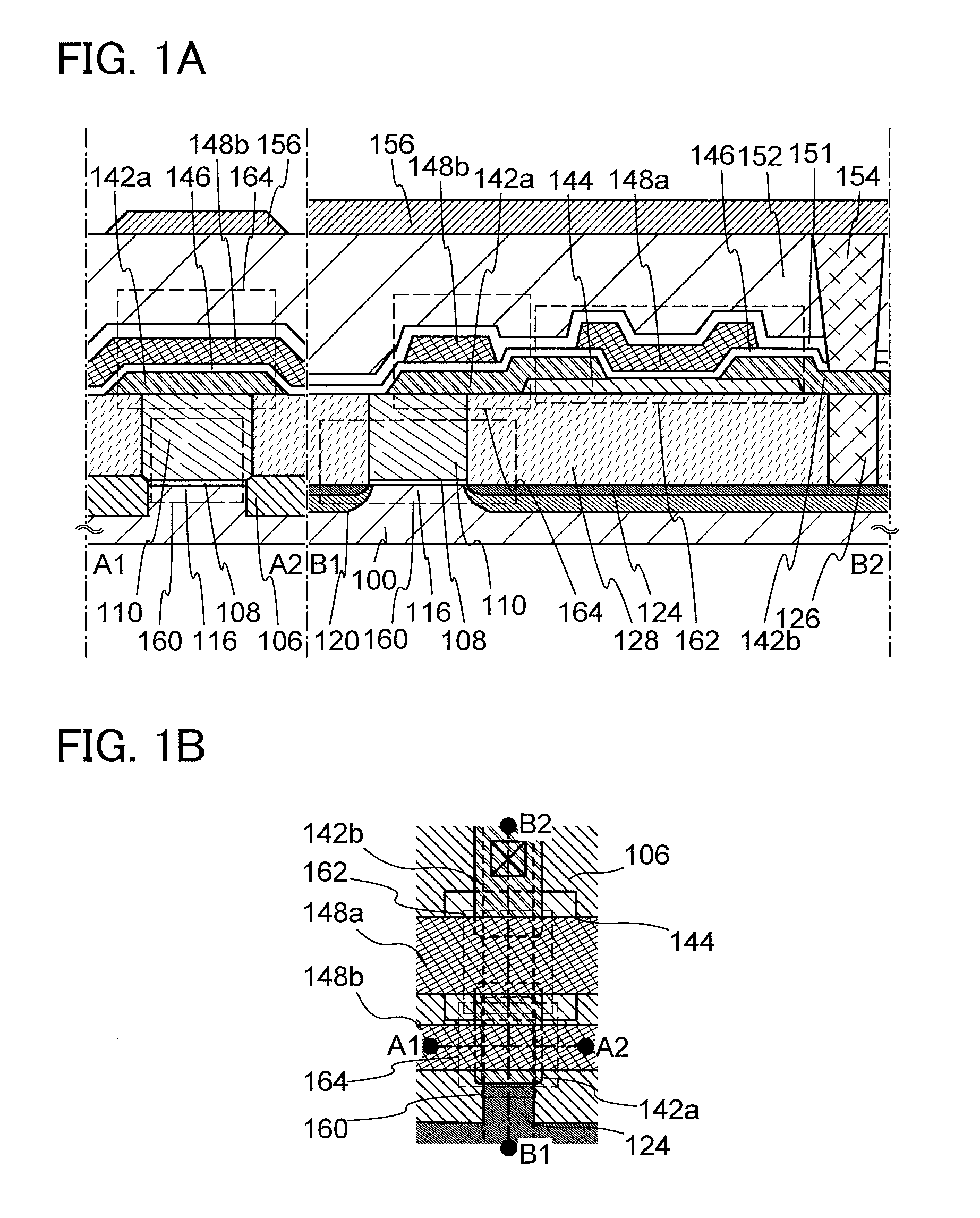Semiconductor device
a technology of semiconductor devices and semiconductors, applied in semiconductor devices, solid-state devices, instruments, etc., can solve the problems of increased cost per storage capacity, difficulty in sufficiently reducing power consumption, and loss of stored data, so as to achieve the effect of increasing the degree of integration and reducing the layout area
- Summary
- Abstract
- Description
- Claims
- Application Information
AI Technical Summary
Benefits of technology
Problems solved by technology
Method used
Image
Examples
embodiment 1
[0048]In this embodiment, a structure of a semiconductor device according to an embodiment of the present invention and a method for manufacturing the semiconductor device will be described with reference to FIGS. 1A and 1B, FIGS. 2A to 2D, FIGS. 3A to 3D, FIGS. 4A to 4C, and FIGS. 5A to 5C.
[0049]FIGS. 1A and 1B illustrate an example of a structure of a semiconductor device. FIG. 1A is a cross-sectional view of the semiconductor device, and FIG. 1B is a plan view of the semiconductor device. Here, FIG. 1A corresponds to a cross section along line A1-A2 and line B1-B2 in FIG. 1B. The semiconductor device illustrated in FIGS. 1A and 1B includes a transistor 160 including a first semiconductor material in a lower portion, and a transistor 162 including a second semiconductor material in an upper portion. Here, the first semiconductor material is preferably different from the second semiconductor material. For example, a semiconductor material other than an oxide semiconductor can be us...
embodiment 2
[0139]In this embodiment, a structure of a semiconductor device according to another embodiment of the invention disclosed herein and a method for manufacturing the semiconductor device will be described with reference to FIGS. 6A and 6B, FIGS. 7A to 7H, FIGS. 8A to 8E, FIGS. 9A to 9C, and FIGS. 10A to 10C.
[0140]FIGS. 6A and 6B illustrate an example of a structure of a semiconductor device according to this embodiment. FIG. 6A is a cross-sectional view of the semiconductor device, and FIG. 6B is a plan view of the semiconductor device. Here, FIG. 6A illustrates a cross section taken along line E1-E2 and line F1-F2 in FIG. 6B. The semiconductor device illustrated in FIGS. 6A and 6B includes a transistor 560 including a first semiconductor material in a lower portion and a transistor 562 including a second semiconductor material in an upper portion. Here, the first semiconductor material is preferably different from the second semiconductor material. For example, the first semiconduct...
embodiment 3
[0220]In this embodiment, a circuit configuration and operation of a semiconductor device according to an embodiment of the invention disclosed herein will be described with reference to FIGS. 11A-1 to 11B. In the description of circuit diagrams in FIGS. 11A-1 to 11B, reference numerals are the same as those in the semiconductor device in FIGS. 1A and 1B. Note that in each of the circuit diagrams, “OS” may be written beside a transistor in order to indicate that the transistor includes an oxide semiconductor.
[0221]In the semiconductor device illustrated in FIG. 11A-1, a first wiring (a 1st line) and a source electrode of a transistor 160 are electrically connected to each other. A second wiring (a 2nd line) and a drain electrode of the transistor 160 are electrically connected to each other. A third wiring (a 3rd line) and one of a source electrode and a drain electrode of a transistor 162 are electrically connected to each other, and a fourth wiring (a 4th line) and a gate electrod...
PUM
 Login to View More
Login to View More Abstract
Description
Claims
Application Information
 Login to View More
Login to View More - R&D
- Intellectual Property
- Life Sciences
- Materials
- Tech Scout
- Unparalleled Data Quality
- Higher Quality Content
- 60% Fewer Hallucinations
Browse by: Latest US Patents, China's latest patents, Technical Efficacy Thesaurus, Application Domain, Technology Topic, Popular Technical Reports.
© 2025 PatSnap. All rights reserved.Legal|Privacy policy|Modern Slavery Act Transparency Statement|Sitemap|About US| Contact US: help@patsnap.com



